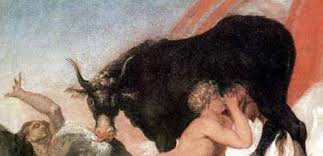|
In reading Gylfaginning I’m intrigued by the combining of the words yeasty and venom. So I scry the internet and learn that the word yeast is Germanic in origin and of course it is the word for the thing that is used in brewing beer and making bread dough rise and it also means spume, foam, ferment, agitation, to be covered with froth. Gylfaginning tells us that there are eleven streams that collectively make up Elivagar (Ice Waves) that finds it source in the wellspring Hvergelmir which is one of the three wells hidden in the roots of the world tree.
It also says that yeasty venom hardened upon these streams and became ice that played a part in the origin of the giant Ymir and the filling of the great Void, Ginnungagap. Continuing to follow the trail, I discovered that the word venom has its roots in the word venerate, which finds it way back to Venus, which is more than a planet and a goddess. Venus originally meant physical desire and sexual appetite. Venom is also a word with connection to the Latin venenum and it doesn’t just mean a poison. It can also be a magical herb or potion. In another place Gylfaginning says, “So many serpents are in Hvergelmir with Nidhogg that no tongue can tell them.” Is it possible that these serpents are the source of the venom spoken of as being yeasty? They all dwell in the roots of Yggdrasil, down there where the wells are. So why do we automatically think that the yeasty venom is poison? Could it be instead a foaming, frothing, agitated, fermenting magical potion that played a part in what emerged from the coming together of the fires of Muspelheim and the ice of Niflheim? Fire and ice are joining hands again at this rhythmic time of global warming. What magical event will occur this time when the yeasty venom is activated?
0 Comments
Your comment will be posted after it is approved.
Leave a Reply. |
title Photo by Amaury Gutierrez on Unsplash
IngridWriters write. Archives
January 2022
Categories
All
|

 RSS Feed
RSS Feed